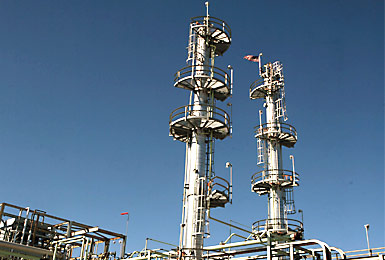Biofuels and the U.S. Navy's "Great Green Fleet"
A series of increasingly demanding Navy biofuel tests culminated in July 2012 with a task force of U.S. Navy ships and aircraft operating off the West Coast powered by biofuels.
August 2012

A series of increasingly demanding Navy biofuel tests culminated in July 2012 with a task force of U.S. Navy ships and aircraft operating off the West Coast powered by biofuels. This "Green Strike Group" evaluated the functionality of biofuels and served as the "final exam" for the Navy's biofuel program. The biofuels performed flawlessly in ships, fighter planes, and helicopters as planned. The Green Strike Group is part of the Rim of the Pacific exercise near Hawaii. Conducted every other year, this is the world's largest maritime exercise. Navies of several U.S. allies take part.
Solazyme, Inc., headquartered in South San Francisco, converts algae and food processing wastes into biofuels. In March the Navy's frigate USS Ford successfully used Soladiesel HRD-76 to power its diesel turbine engines on a voyage from Everett, Washington, to San Diego. The Navy's most advanced fighter plane, the FA-18, and several other types of aircraft have also tested biofuels.
Using Solazyme's Bio-Synfining™ process, Dynamic Fuels LLC is converting beef tallow and chicken fat into synthetic diesel fuel. Some of this is being converted into jet fuel, resulting in a total production of 100,000 gallons of jet fuel and 350,000 gallons of diesel marine distillate fuel at its plant in Geismar, Louisiana. The plant, a 50:50 Solazyme-Tyson Foods joint venture, employs 300 people. Delivery to supply the fuel needed for the Navy's 2012 fleet tests took place in May. Geismar is already a major petrochemical center and has excellent transportation connections, being on both the Mississippi River and a major interstate highway, I-10, and having good rail connections as well.
Though miniscule compared to the Navy's annual fuel demand of 1.26 billion gallons, the 450,000 gallons of biofuel on order for 2012 are a key milestone in developing economies of scale and reducing biofuel costs to levels comparable to conventional fuels based on petroleum.
The Green Strike Group isn't the end of the biofuels program. The Navy intends to have an entire fleet of warships known as the "Great Green Fleet" running on biofuels by 2016. The goal is to have half the entire Navy running on biofuels by 2020.
A major aim of the Navy program is to integrate different kinds of non-food feedstocks into standardized biofuels. This could help scale up global biofuel production more rapidly than a single-feedstock focus. A $510 million partnership between the departments of Agriculture, Energy, and Navy and private-sector firms is designed to help build a growing supply of domestic biofuel made from nonfuel sources, while creating new jobs in biorefining, transportation, and related operations, particularly in rural areas.
Project Announcements
Kimberly-Clark Expands Aiken County, South Carolina, Distribution Operations
05/04/2025
Aerowerks Plans Gaffney, South Carolina, Manufacturing Operations
05/04/2025
Sweden-Based Troax Group Plans Portland, Tennessee, Manufacturing Operations
05/04/2025
Kimberly-Clark Corporation Plans Warren, Ohio, Manufacturing Operations
05/04/2025
Denmark-Based Novonesis Expands Salem, Virginia, Production Operations
05/04/2025
Polyvlies USA Expands Winston-Salem, North Carolina, Manufacturing Operations
05/04/2025
Most Read
-
Run a Job Task Analysis
Q4 2024
-
39th Annual Corporate & 21st Annual Consultants Surveys: What Business Leaders and Consultants Are Saying About Site Selection
Q1 2025
-
The Location Economics of Advanced Nuclear
Q1 2025
-
Why Workforce Readiness Can’t Wait
Q1 2025
-
Power, Policy, and Site Selection in 2025
Q1 2025
-
Is It Time to Start Planning for Quantum Data Centers?
Q1 2025
-
Top States for Doing Business in 2024: A Continued Legacy of Excellence
Q3 2024



